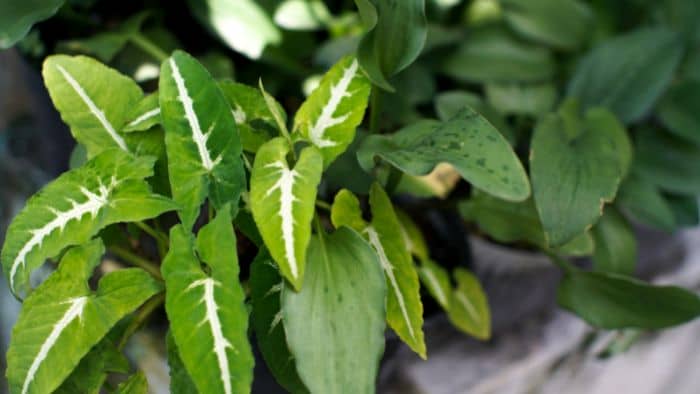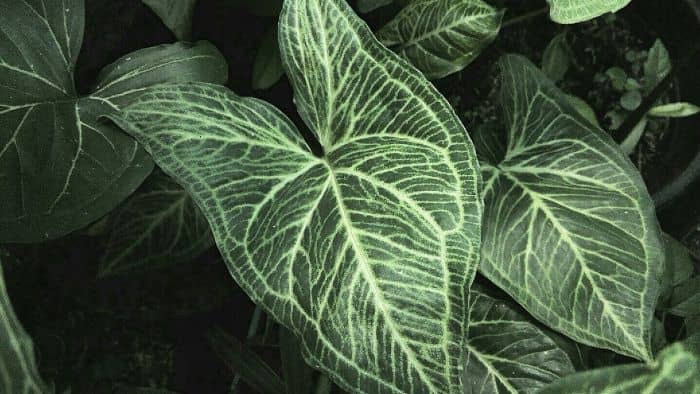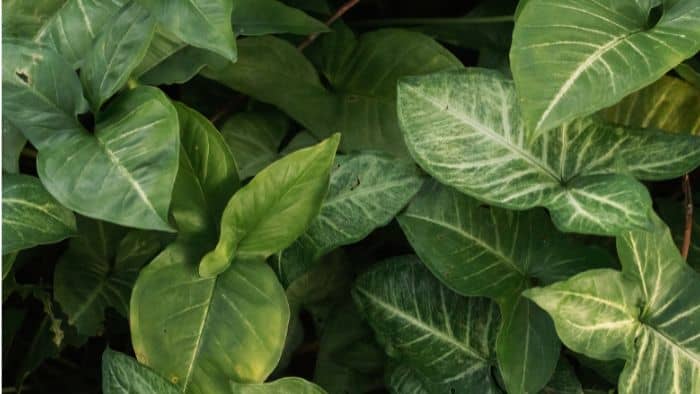If you want information about the Best Soil for Syngonium, then this article is aimed at you! Tropical plants with stunning spade-shaped foliage include arrowhead plants, also known as Syngonium. These plants need soil that is nutrient-rich with exceptional water drainage properties to thrive. Your arrowhead plant won’t grow well if the soil is the wrong combination.
Tropical rainforests in southern Mexico, the West Indies, Central America, and South America are the natural habitat of the flowering plant genus Syngonium. These plants belong to the Araceae family and have woody vines that can climb heights of about 20 meters. They prefer acidic soil, with a pH range of 5.5 and 6.5.
The soil mix should also have excellent aeration properties and enhanced structure and be able to hold onto the moisture that these plants require to grow their best. Let’s go into more detail about the ideal blend that will result in a well-balanced soil mix for arrowhead plants.
What Is The Best Syngonium Potting Mix?
Before selecting the best potting for Syngonium, it is crucial to understand the requirements of your plant. Tropical rainforests, where the soil is nutrient-rich, are the habitat of arrowhead plants. These tiny plants develop beneath large trees which benefits them. This is because the dead, dried leaves that fall from the trees provide the soil with nutrients and make it productive.
However, if you’re growing it as a houseplant, it won’t be exposed to the conditions of its natural habitat. Therefore, you should prepare a potting mix that is fertile enough for your plant to thrive. Keep in mind that because Syngonium is prone to root rot, it needs light and well-drained soil. Additionally, when preparing the soil, make sure that it can retain enough moisture to keep the plant healthy.
You must also create a light soil mixture that allows the roots to breathe rather than a heavy one that compacts. Have a look at the potting mix recipe below for your plant.

Recipe
You can add these ingredients to a typical potting mix in the following ratio:
– Two parts pumice – This aids in improving soil drainage. Pumice can also be substituted with perlite.
– One part charcoal – It enhances the soil’s ability to drain while absorbing any odors.
– One part coco coir – Coco coir improves the soil’s ability to retain moisture and provides aeration. It also has a neutral pH value which is great for Syngonium.
Do Syngoniums Like Humidity?
Like many indoor plants, Syngonium also has its demands and preferences. Adhering to them will afford you a thriving arrowhead plant that will be able to reach its full potential if grown in the right conditions. Listed below are a few tips that you should take heed of to maintain a thriving plant.
Tips:
- Avoid drafts of hot or cold air that could harm your Syngonium.
- In the spring and summer, you can feed your Syngonium with a balanced liquid fertilizer.
- Tropical houseplants require high humidity levels of at least 50%.
- You can spritz plant leaves, place the plant on a pebble tray, or use a room humidifier to increase the humidity in an enclosed space.
- Syngonium should be grown in bright, indirect light.
- In the spring and summer, water frequently, allowing the soil to dry out in between.
- Even volatile chemical molecules like benzene, formaldehyde, toluene, and xylene can be reduced by these plants, which are major contributors to indoor air pollution.
- With their glossy, textured, and patterned leaves, they make excellent indoor plants.
- These plants are a great choice for tabletops, windowsills, living rooms, and hallways and can be decorated with ornamental pots.

How To Care For Syngonium?
Arrowhead vines spread out in all directions, despite the fact that they begin life as charming, compact, and well-behaved indoor plants. These vigorous growers love to be trained and will develop larger plants when pruned back. As long as you remember to water them, Syngonium plants are low-maintenance. They can grow almost any place in your house and are low-light tolerant houseplants.
Using the best soil for Syngoniums and giving it the proper care will aid it in reaching its full potential in no time. To encourage growth, try using a stake, trellis, or a wall that it can use to climb. This is because their aerial roots cling to objects. Listed below are a few vital care tips that you can easily implement.
Light Preferences
Even though these plants can tolerate very little light, they will develop more quickly and keep their vivid colors and markings if they are exposed to bright indirect light for at least six hours each day. Keep in mind that their leaves will burn in the full sun. If your space lacks natural light, you can also grow Syngonium with artificial lighting.
Water Requirements
Between waterings, let these indoor plants partially dry out. If the soil is left damp for a lengthy period of time, the leaves will become yellow or brown. This is because when a plant is overwatered, the soil becomes saturated, which prevents oxygen from getting to the roots. The soil’s bog-like quality makes it the ideal breeding ground for bacteria and illness.

Soil Recommendations
The ideal growing medium for all Syngonium is potting soil, which is rich in minerals and organic matter and has the capacity to drain properly. The majority of coco coir or peat-based potting soil mixtures are sufficient. However, ensure that they don’t contain water-retentive crystals, which can keep the soil perpetually damp and cause root rot. Alternatively, you could easily make your own potting blend by following the recipe in this article.
Temperature Requirements
In most places, where the temperature ranges from 60 to 80 F, Syngonium can grow quite well. Keep in mind that they dislike temperatures that go below 50 F. In the winter, keep them away from entrances and drafts.
Fertilizer
During the growing season, these plants should be fertilized twice a month with a liquid fertilizer. Alternately, apply a slow-release fertilizer or top dress in the early spring with compost or worm castings. These plants grow quickly and benefit from fertilization because it will aid in the development of huge leaves and a strong root system.
How To Propagate A Syngonium?
Propagating Syngonium is quite a simple process. Keep in mind that these plants will need to be pruned because they grow quickly and become thick. This is because the ends of their thick, delicate stems have a tendency to become heavily covered with leaf growth. To maintain their shape, trimming the ends from time to time is recommended.

Arrowhead stem cuttings can be used in two straightforward methods to propagate plants. Because the roots grow more quickly in warmer weather, propagation is best done in the spring, summer, and fall. However, it is important that they’re planted in the best soil for favorable results. Follow the tips below to successfully propagate your plant.
Tips:
1. Before taking the cuttings, make sure your pruners are clean and sharp.
2. Take the cuts slightly below a node at the desired length.
3. Make sure the stems are long enough to submerge in the water.
4. Take a few of the stems’ bottom leaves off.
5. After the cuttings are kept in water for around two weeks, roots should be visible on the stems.
6. Thereafter, plant them in a container with a succulent soil mix and add water.
7. They will root in about a week and become sturdy inside the soil mix.
For more on Syngonium plant care, here’s a great video.
Conclusion
Syngonium has a wide variety of leaf forms, hues, and variegations. They all can be propagated using the technique above. In their natural habitats, they have vast and deep roots that grow rapidly. Arrowhead vines make the ideal houseplant for those with little to no expertise in gardening practices.
Additionally, they can be grown for a very long time without fertilizer and in practically any location with very little light. Remember to trim the foliage back to preserve the plant’s shape if you prefer a compact, full plant. Also, before you cultivate any indoor plants, make sure they are not patented.
Every few weeks, give your arrowhead vines a wipe with water and a cloth to clean their leaves. By doing this, dust and potential bugs won’t gather and infest your tropical plant. Rotating your plant whenever you water it will also ensure even light distribution. Keep in mind that your plant will receive all the nutrition it needs if you use the best soil for Syngonium. Here is more information about these beautiful shrubs.

